fuel filter Seat Ibiza ST 2016 Owner's manual
[x] Cancel search | Manufacturer: SEAT, Model Year: 2016, Model line: Ibiza ST, Model: Seat Ibiza ST 2016Pages: 252, PDF Size: 5.56 MB
Page 43 of 252
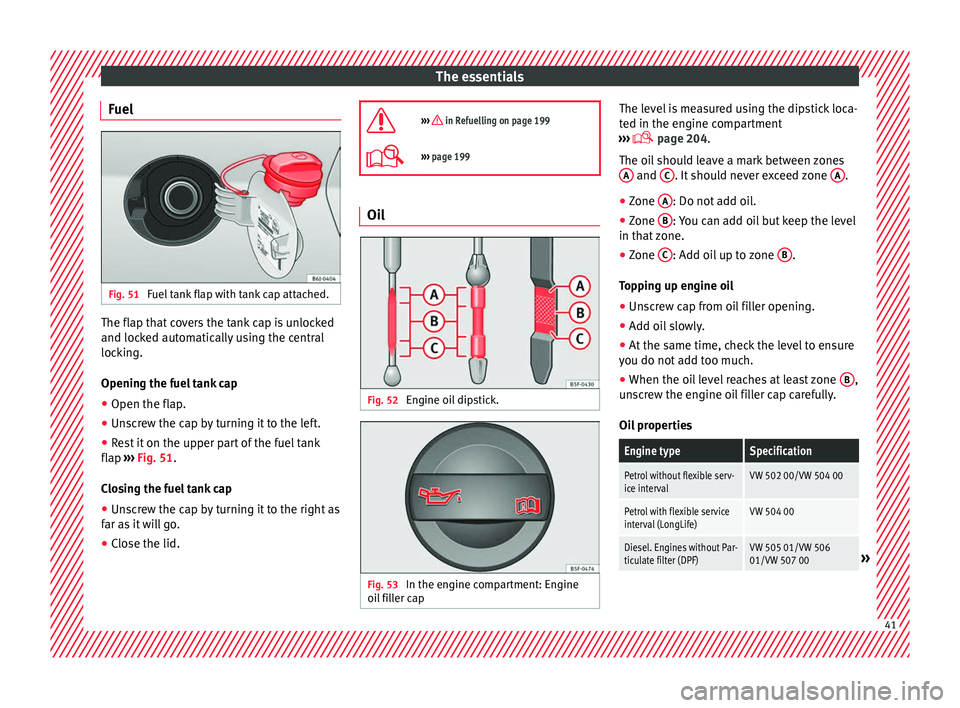
The essentials
Fuel Fig. 51
Fuel tank flap with tank cap attached. The flap that covers the tank cap is unlocked
and loc
k
ed aut om
atically using the central
locking.
Opening the fuel tank cap
● Open the flap.
● Unscrew the cap by turning it to the left.
● Rest it on the upper part of the fuel tank
flap ›››
Fig. 51.
Closing the fuel tank cap
● Unscrew the cap by turning it to the right as
far as it
will go.
● Close the lid.
››› in Refuelling on page 199
›››
page 199 Oil
Fig. 52
Engine oil dipstick. Fig. 53
In the engine compartment: Engine
oi l
fi l
ler cap The level is measured using the dipstick loca-
t
ed in the en
gine comp
artment
››› page 204.
The oil should leave a mark between zones A and
C . It should never exceed zone
A .
● Zone A : Do not add oil.
● Zone B : You can add oil but keep the level
in th at
z
one.
● Zone C : Add oil up to zone
B .
T op
pin g up en
gine oil
● Unscrew cap from oil filler opening.
● Add oil slowly.
● At the same time, check the level to ensure
you do not ad
d too much.
● When the oil level reaches at least zone B ,
u n
sc
rew the engine oil filler cap carefully.
Oil properties
Engine typeSpecification
Petrol without flexible serv-
ice intervalVW 502 00/VW 504 00
Petrol with flexible service
interval (LongLife)VW 504 00
Diesel. Engines without Par-
ticulate filter (DPF)VW 505 01/VW 506
01/VW 507 00» 41
Page 84 of 252
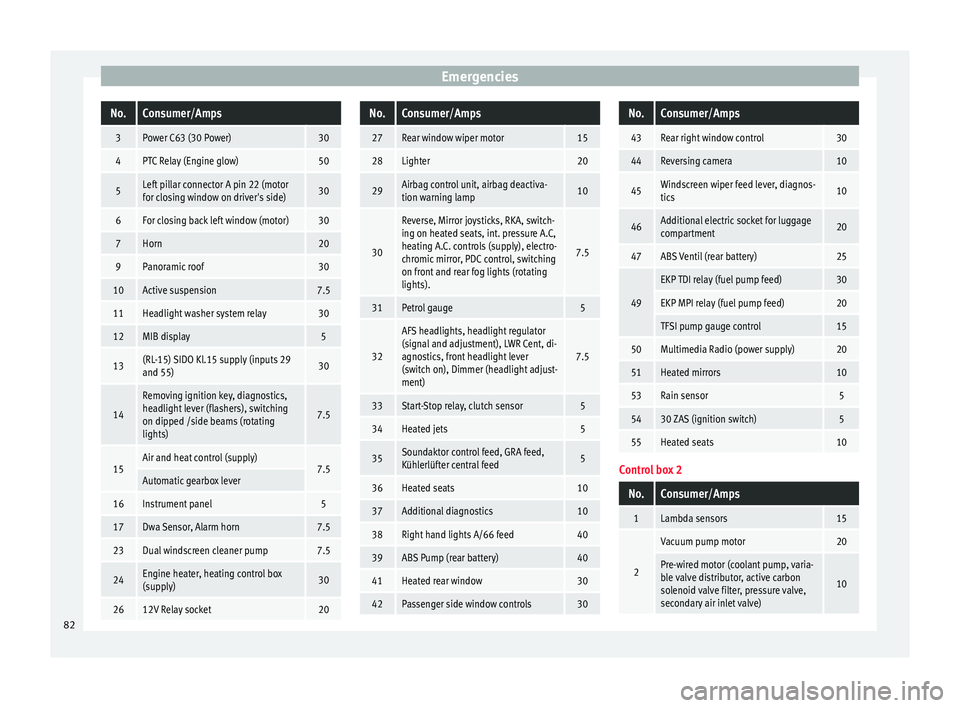
EmergenciesNo.Consumer/Amps
3Power C63 (30 Power)30
4PTC Relay (Engine glow)50
5Left pillar connector A pin 22 (motor
for closing window on driver's side)30
6For closing back left window (motor)30
7Horn20
9Panoramic roof30
10Active suspension7.5
11Headlight washer system relay30
12MIB display5
13(RL-15) SIDO Kl.15 supply (inputs 29
and 55)30
14
Removing ignition key, diagnostics,
headlight lever (flashers), switching
on dipped /side beams (rotating
lights)
7.5
15Air and heat control (supply)7.5Automatic gearbox lever
16Instrument panel5
17Dwa Sensor, Alarm horn7.5
23Dual windscreen cleaner pump7.5
24Engine heater, heating control box
(supply)30
2612V Relay socket20
No.Consumer/Amps
27Rear window wiper motor15
28Lighter20
29Airbag control unit, airbag deactiva-
tion warning lamp10
30
Reverse, Mirror joysticks, RKA, switch-
ing on heated seats, int. pressure A.C,
heating A.C. controls (supply), electro-
chromic mirror, PDC control, switching
on front and rear fog lights (rotating
lights).
7.5
31Petrol gauge5
32
AFS headlights, headlight regulator
(signal and adjustment), LWR Cent, di-
agnostics, front headlight lever
(switch on), Dimmer (headlight adjust-
ment)
7.5
33Start-Stop relay, clutch sensor5
34Heated jets5
35Soundaktor control feed, GRA feed,
Kühlerlüfter central feed5
36Heated seats10
37Additional diagnostics10
38Right hand lights A/66 feed40
39ABS Pump (rear battery)40
41Heated rear window30
42Passenger side window controls30
No.Consumer/Amps
43Rear right window control30
44Reversing camera10
45Windscreen wiper feed lever, diagnos-
tics10
46Additional electric socket for luggage
compartment20
47ABS Ventil (rear battery)25
49
EKP TDI relay (fuel pump feed)30
EKP MPI relay (fuel pump feed)20
TFSI pump gauge control15
50Multimedia Radio (power supply)20
51Heated mirrors10
53Rain sensor5
5430 ZAS (ignition switch)5
55Heated seats10
Control box 2
No.Consumer/Amps
1Lambda sensors15
2
Vacuum pump motor20
Pre-wired motor (coolant pump, varia-
ble valve distributor, active carbon
solenoid valve filter, pressure valve,
secondary air inlet valve)
10
82
Page 150 of 252
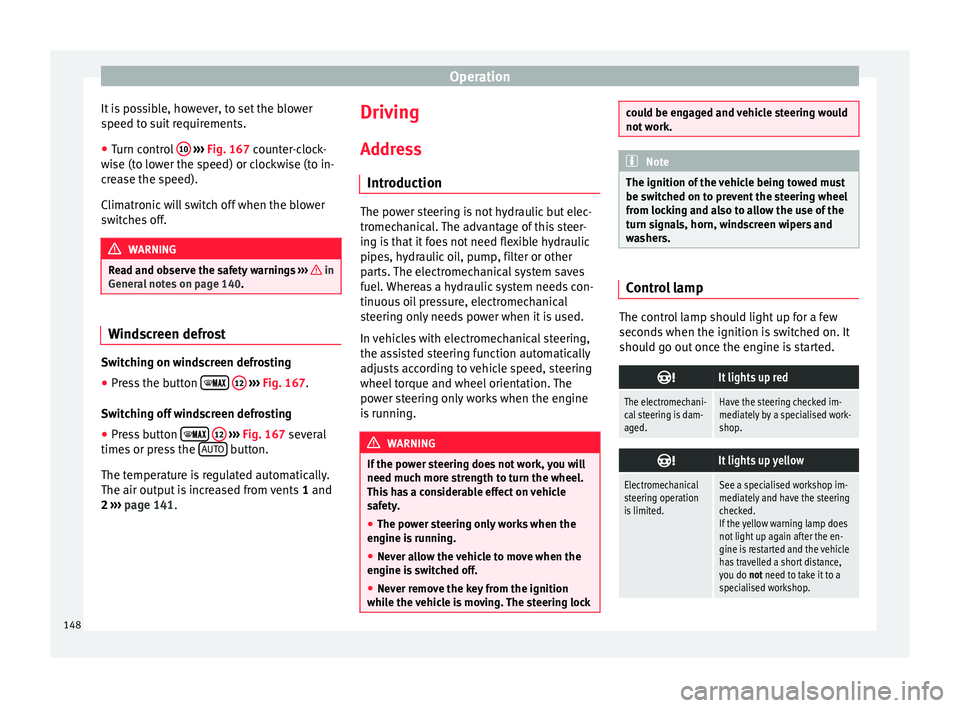
Operation
It is possible, however, to set the blower
s peed t
o suit
requirements.
● Turn control 10
› ››
Fig. 167
cou
nter-clock-
wise (to lower the speed) or clockwise (to in-
crease the speed).
Climatronic will switch off when the blower
switches off. WARNING
Read and observe the safety warnings ››› in
General not
es on page 140. Windscreen defrost
Switching on windscreen defrosting
●
Press the button
12
› ›
›
Fig. 167
.
Switching off windscreen defrosting
● Press button
12
› ›
›
Fig. 167
several
times or press the AUTO button.
The t emper
atur
e is regulated automatically.
The air output is increased from vents 1 and
2 ›››
page 141. Driving
Ad dr
es
s
Introduction The power steering is not hydraulic but elec-
tromech
anic
al. The advantage of this steer-
ing is that it foes not need flexible hydraulic
pipes, hydraulic oil, pump, filter or other
parts. The electromechanical system saves
fuel. Whereas a hydraulic system needs con-
tinuous oil pressure, electromechanical
steering only needs power when it is used.
In vehicles with electromechanical steering,
the assisted steering function automatically
adjusts according to vehicle speed, steering
wheel torque and wheel orientation. The
power steering only works when the engine
is running. WARNING
If the power steering does not work, you will
need much more s tr
ength to turn the wheel.
This has a considerable effect on vehicle
safety.
● The power steering only works when the
engine is ru
nning.
● Never allow the vehicle to move when the
engine is sw
itched off.
● Never remove the key from the ignition
while the v
ehicle is moving. The steering lock could be engaged and vehicle steering would
not work.
Note
The ignition of the vehicle being towed must
be sw itched on t
o prevent the steering wheel
from locking and also to allow the use of the
turn signals, horn, windscreen wipers and
washers. Control lamp
The control lamp should light up for a few
sec
ond
s when the ignition i
s switched on. It
should go out once the engine is started.
It lights up red
The electromechani-
cal steering is dam-
aged.Have the steering checked im-
mediately by a specialised work-
shop.
It lights up yellow
Electromechanical
steering operation
is limited.See a specialised workshop im-
mediately and have the steering
checked.
If the yellow warning lamp does
not light up again after the en-
gine is restarted and the vehicle
has travelled a short distance,
you do not need to take it to a
specialised workshop. 148
Page 163 of 252
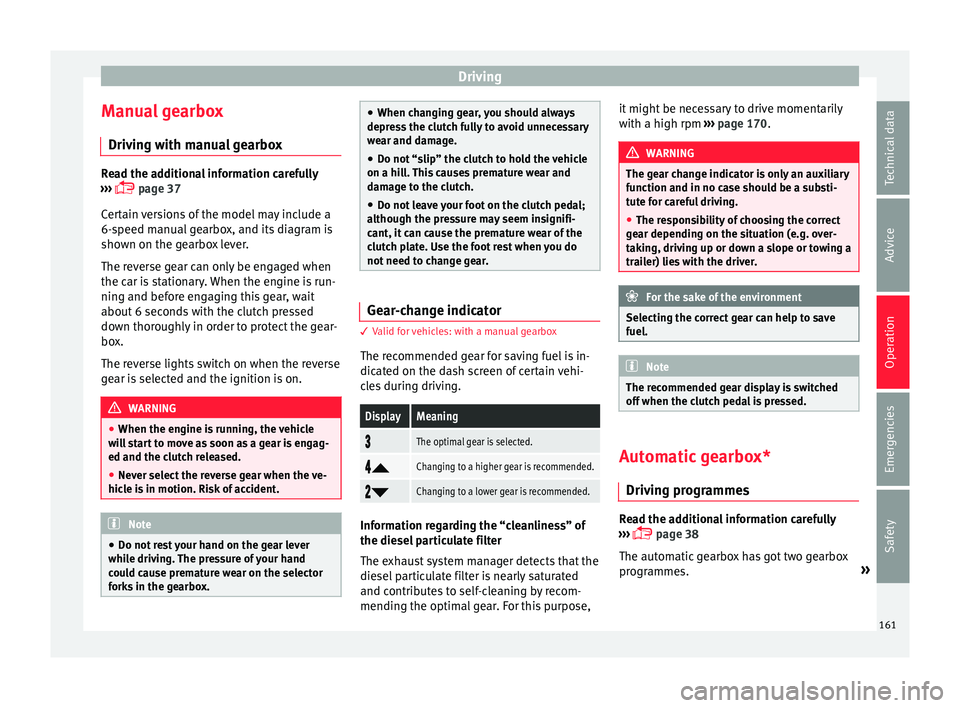
Driving
Manual gearbox Driv in
g w ith m
anual gearboxRead the additional information carefully
›››
p
age 37
Certain versions of the model may include a
6-speed manual gearbox, and its diagram is
shown on the gearbox lever.
The reverse gear can only be engaged when
the car is stationary. When the engine is run-
ning and before engaging this gear, wait
about 6 seconds with the clutch pressed
down thoroughly in order to protect the gear-
box.
The reverse lights switch on when the reverse
gear is selected and the ignition is on. WARNING
● When the engine is ru
nning, the vehicle
will start to move as soon as a gear is engag-
ed and the clutch released.
● Never select the reverse gear when the ve-
hicle is
in motion. Risk of accident. Note
● Do not re s
t your hand on the gear lever
while driving. The pressure of your hand
could cause premature wear on the selector
forks in the gearbox. ●
When chan gin
g gear, you should always
depress the clutch fully to avoid unnecessary
wear and damage.
● Do not “slip” the clutch to hold the vehicle
on a hill.
This causes premature wear and
damage to the clutch.
● Do not leave your foot on the clutch pedal;
although the pres
sure may seem insignifi-
cant, it can cause the premature wear of the
clutch plate. Use the foot rest when you do
not need to change gear. Gear-change indicator
3 Valid for vehicles: with a manual gearbox
The r ec
ommended gear for saving fuel is in-
dicated on the dash screen of certain vehi-
cles during driving.
DisplayMeaning
The optimal gear is selected.
Changing to a higher gear is recommended.
Changing to a lower gear is recommended.
Information regarding the “cleanliness” of
the die
sel
par
ticulate filter
The exhaust system manager detects that the
diesel particulate filter is nearly saturated
and contributes to self-cleaning by recom-
mending the optimal gear. For this purpose, it might be necessary to drive momentarily
with a high rpm
›››
page 170. WARNING
The gear change indicator is only an auxiliary
function and in no c a
se should be a substi-
tute for careful driving.
● The responsibility of choosing the correct
gear depending on the s
ituation (e.g. over-
taking, driving up or down a slope or towing a
trailer) lies with the driver. For the sake of the environment
Selecting the correct gear can help to save
fuel. Note
The recommended gear display is switched
off when the clut c
h pedal is pressed. Automatic gearbox*
Driv ing pr
ogr
ammes Read the additional information carefully
› ›
›
p
age 38
The automatic gearbox has got two gearbox
programmes. »
161
Technical data
Advice
Operation
Emergencies
Safety
Page 172 of 252
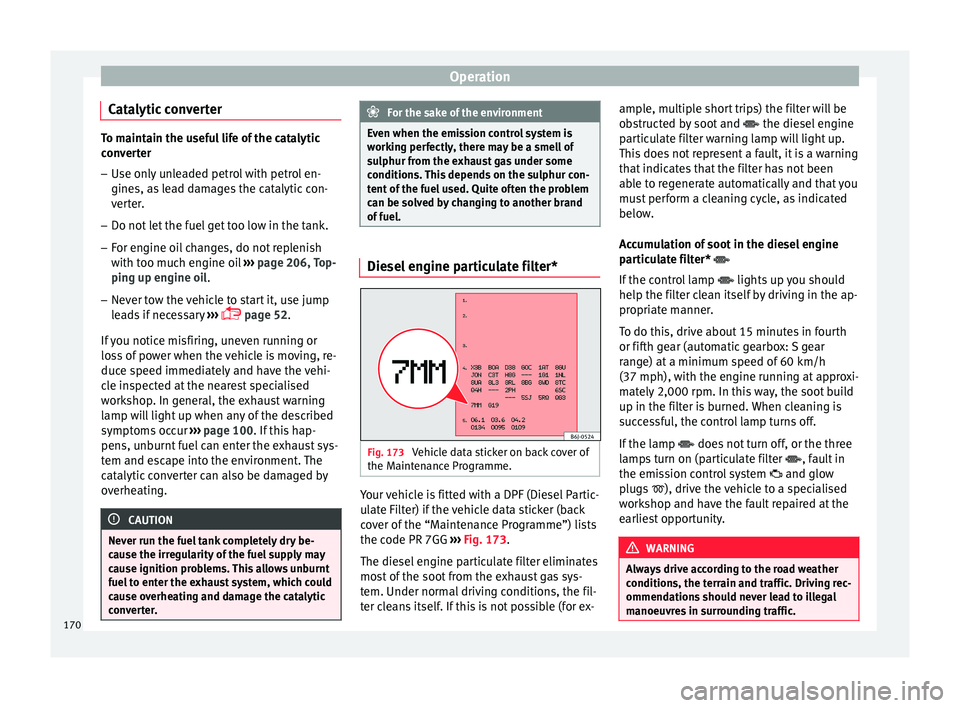
Operation
Catalytic converter To maintain the useful life of the catalytic
conv
er
ter
– Use only unleaded petrol with petrol en-
gines, as l
ead damages the catalytic con-
verter.
– Do not let the fuel get too low in the tank.
– For engine oil changes, do not replenish
with too much en
gine oil ››› page 206, Top-
ping up engine oil.
– Never tow the vehicle to start it, use jump
lea d
s if necessary ›››
page 52.
If you notice misfiring, uneven running or
loss of power when the vehicle is moving, re-
duce speed immediately and have the vehi-
cle inspected at the nearest specialised
workshop. In general, the exhaust warning
lamp will light up when any of the described
symptoms occur ›››
page 100. If this hap-
pens, unburnt fuel can enter the exhaust sys-
tem and escape into the environment. The
catalytic converter can also be damaged by
overheating. CAUTION
Never run the fuel tank completely dry be-
cause the irr e
gularity of the fuel supply may
cause ignition problems. This allows unburnt
fuel to enter the exhaust system, which could
cause overheating and damage the catalytic
converter. For the sake of the environment
Even when the emission control system is
workin g per
fectly, there may be a smell of
sulphur from the exhaust gas under some
conditions. This depends on the sulphur con-
tent of the fuel used. Quite often the problem
can be solved by changing to another brand
of fuel. Diesel engine particulate filter*
Fig. 173
Vehicle data sticker on back cover of
the M aint
enanc
e Programme. Your vehicle is fitted with a DPF (Diesel Partic-
u
l
at e Fi
lter) if the vehicle data sticker (back
cover of the “Maintenance Programme”) lists
the code PR 7GG ››› Fig. 173.
The diesel engine particulate filter eliminates
most of the soot from the exhaust gas sys-
tem. Under normal driving conditions, the fil-
ter cleans itself. If this is not possible (for ex- ample, multiple short trips) the filter will be
obstruct
ed by soot and the diesel engine
particulate filter warning lamp will light up.
This does not represent a fault, it is a warning
that indicates that the filter has not been
able to regenerate automatically and that you
must perform a cleaning cycle, as indicated
below.
Accumulation of soot in the diesel engine
particulate filter*
If the control lamp lights up you should
help the filter clean itself by driving in the ap-
propriate manner.
To do this, drive about 15 minutes in fourth
or fifth gear (automatic gearbox: S gear
range) at a minimum speed of 60 km/h
(37 mph), with the engine running at approxi-
mately 2,000 rpm. In this way, the soot build
up in the filter is burned. When cleaning is
successful, the control lamp turns off.
If the lamp does not turn off, or the three
lamps turn on (particulate filter , fault in
the emission control system and glow
plugs ), drive the vehicle to a specialised
workshop and have the fault repaired at the
earliest opportunity. WARNING
Always drive according to the road weather
conditions, the t err
ain and traffic. Driving rec-
ommendations should never lead to illegal
manoeuvres in surrounding traffic. 170
Page 173 of 252
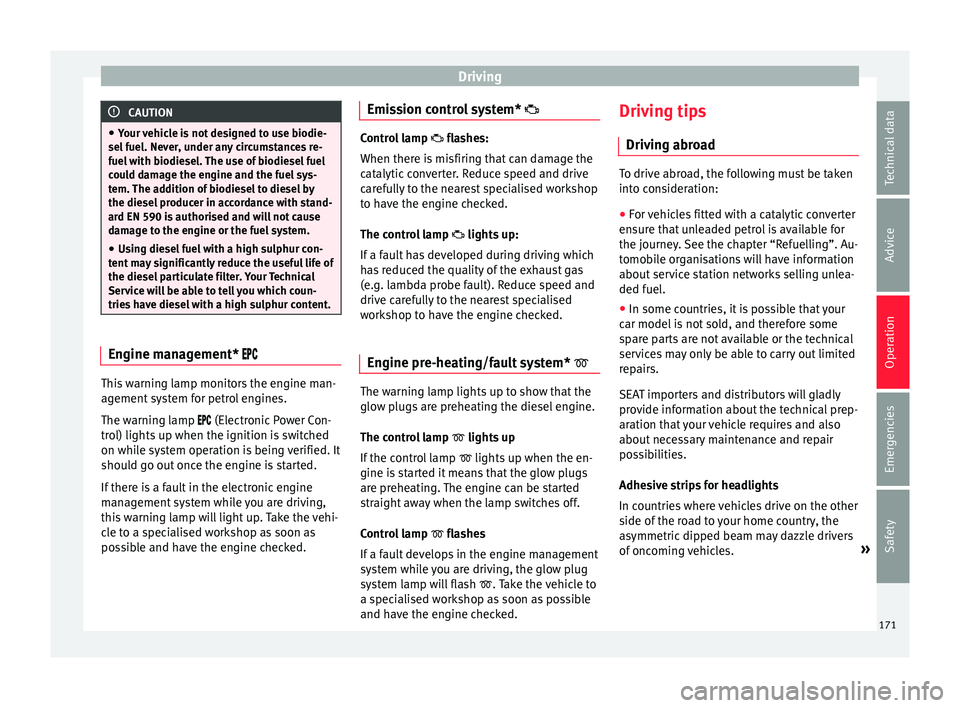
Driving
CAUTION
● Your v ehic
le is not designed to use biodie-
sel fuel. Never, under any circumstances re-
fuel with biodiesel. The use of biodiesel fuel
could damage the engine and the fuel sys-
tem. The addition of biodiesel to diesel by
the diesel producer in accordance with stand-
ard EN 590 is authorised and will not cause
damage to the engine or the fuel system.
● Using diesel fuel with a high sulphur con-
tent ma
y significantly reduce the useful life of
the diesel particulate filter. Your Technical
Service will be able to tell you which coun-
tries have diesel with a high sulphur content. Engine management*
This warning lamp monitors the engine man-
ag
ement
sys
tem for petrol engines.
The warning lamp (Electronic Power Con-
trol) lights up when the ignition is switched
on while system operation is being verified. It
should go out once the engine is started.
If there is a fault in the electronic engine
management system while you are driving,
this warning lamp will light up. Take the vehi-
cle to a specialised workshop as soon as
possible and have the engine checked. Emission control system* Control lamp
flashes:
When ther
e is misfiring that can damage the
catalytic converter. Reduce speed and drive
carefully to the nearest specialised workshop
to have the engine checked.
The control lamp lights up:
If a fault has developed during driving which
has reduced the quality of the exhaust gas
(e.g. lambda probe fault). Reduce speed and
drive carefully to the nearest specialised
workshop to have the engine checked.
Engine pre-heating/fault system* The warning lamp lights up to show that the
glo
w p
lugs
are preheating the diesel engine.
The control lamp lights up
If the control lamp lights up when the en-
gine is started it means that the glow plugs
are preheating. The engine can be started
straight away when the lamp switches off.
Control lamp flashes
If a fault develops in the engine management
system while you are driving, the glow plug
system lamp will flash . Take the vehicle to
a specialised workshop as soon as possible
and have the engine checked. Driving tips
Driving abro
ad To drive abroad, the following must be taken
into con
s
ideration:
● For vehicles fitted with a catalytic converter
ensure th
at unleaded petrol is available for
the journey. See the chapter “Refuelling”. Au-
tomobile organisations will have information
about service station networks selling unlea-
ded fuel.
● In some countries, it is possible that your
car model i s
not sold, and therefore some
spare parts are not available or the technical
services may only be able to carry out limited
repairs.
SEAT importers and distributors will gladly
provide information about the technical prep-
aration that your vehicle requires and also
about necessary maintenance and repair
possibilities.
Adhesive strips for headlights
In countries where vehicles drive on the other
side of the road to your home country, the
asymmetric dipped beam may dazzle drivers
of oncoming vehicles. »
171
Technical data
Advice
Operation
Emergencies
Safety
Page 194 of 252
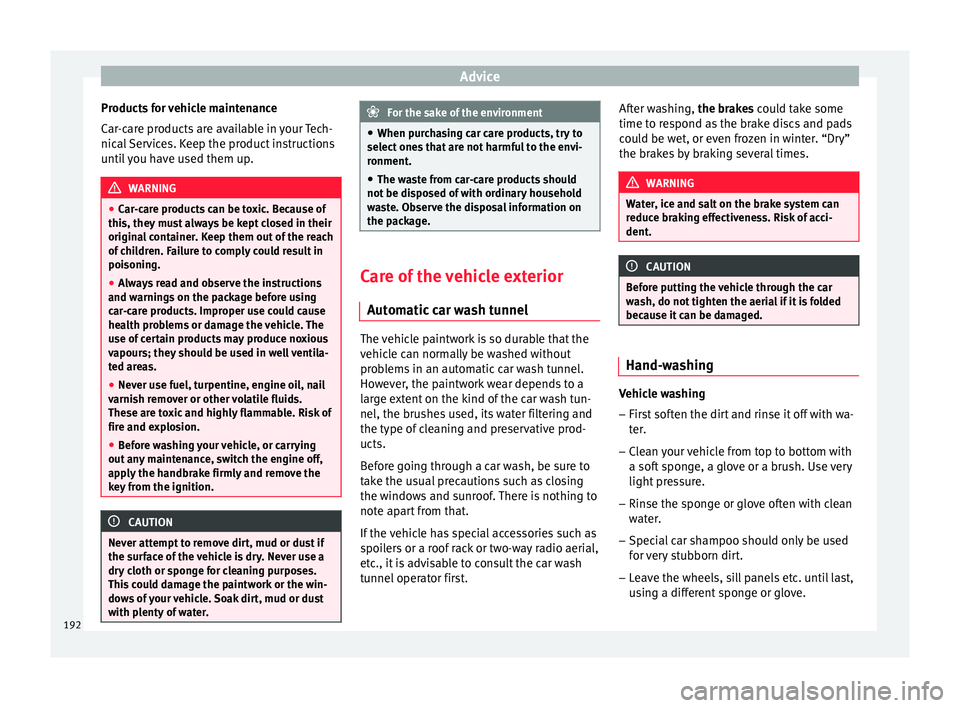
Advice
Products for vehicle maintenance
C ar
-car
e products are available in your Tech-
nical Services. Keep the product instructions
until you have used them up. WARNING
● Car-c ar
e products can be toxic. Because of
this, they must always be kept closed in their
original container. Keep them out of the reach
of children. Failure to comply could result in
poisoning.
● Always read and observe the instructions
and warnings
on the package before using
car-care products. Improper use could cause
health problems or damage the vehicle. The
use of certain products may produce noxious
vapours; they should be used in well ventila-
ted areas.
● Never use fuel, turpentine, engine oil, nail
varnish remo
ver or other volatile fluids.
These are toxic and highly flammable. Risk of
fire and explosion.
● Before washing your vehicle, or carrying
out any m
aintenance, switch the engine off,
apply the handbrake firmly and remove the
key from the ignition. CAUTION
Never attempt to remove dirt, mud or dust if
the surf ac
e of the vehicle is dry. Never use a
dry cloth or sponge for cleaning purposes.
This could damage the paintwork or the win-
dows of your vehicle. Soak dirt, mud or dust
with plenty of water. For the sake of the environment
● When purc h
asing car care products, try to
select ones that are not harmful to the envi-
ronment.
● The waste from car-care products should
not be dispo
sed of with ordinary household
waste. Observe the disposal information on
the package. Care of the vehicle exterior
Automatic c
ar wash tunnel The vehicle paintwork is so durable that the
v
ehic
le c
an normally be washed without
problems in an automatic car wash tunnel.
However, the paintwork wear depends to a
large extent on the kind of the car wash tun-
nel, the brushes used, its water filtering and
the type of cleaning and preservative prod-
ucts.
Before going through a car wash, be sure to
take the usual precautions such as closing
the windows and sunroof. There is nothing to
note apart from that.
If the vehicle has special accessories such as
spoilers or a roof rack or two-way radio aerial,
etc., it is advisable to consult the car wash
tunnel operator first. After washing, the brakes
could take some
time to respond as the brake discs and pads
could be wet, or even frozen in winter. “Dry”
the brakes by braking several times. WARNING
Water, ice and salt on the brake system can
reduce br ak
ing effectiveness. Risk of acci-
dent. CAUTION
Before putting the vehicle through the car
wash, do not tight
en the aerial if it is folded
because it can be damaged. Hand-washing
Vehicle washing
– First soften the dirt and rinse it off with wa-
ter
.
– Cl
ean your vehicle from top to bottom with
a soft spon
ge, a glove or a brush. Use very
light pressure.
– Rinse the sponge or glove often with clean
water.
– S
pecial car shampoo should only be used
for ver
y stubborn dirt.
– Leave the wheels, sill panels etc. until last,
using a diff
erent sponge or glove.
192
Page 203 of 252
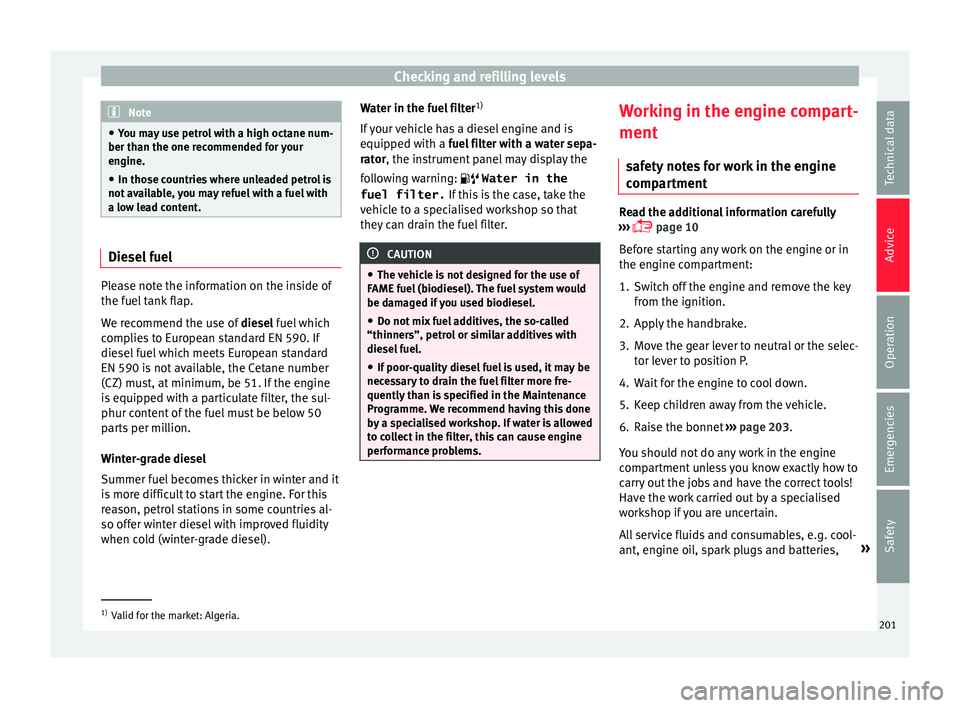
Checking and refilling levels
Note
● You ma y
use petrol with a high octane num-
ber than the one recommended for your
engine.
● In those countries where unleaded petrol is
not avail
able, you may refuel with a fuel with
a low lead content. Diesel fuel
Please note the information on the inside of
the f
uel
tank
flap.
We recommend the use of diesel fuel which
complies to European standard EN 590. If
diesel fuel which meets European standard
EN 590 is not available, the Cetane number
(CZ) must, at minimum, be 51. If the engine
is equipped with a particulate filter, the sul-
phur content of the fuel must be below 50
parts per million.
Winter-grade diesel
Summer fuel becomes thicker in winter and it
is more difficult to start the engine. For this
reason, petrol stations in some countries al-
so offer winter diesel with improved fluidity
when cold (winter-grade diesel). Water in the fuel filter
1)
If your
vehicle has a diesel engine and is
equipped with a fuel filter with a water sepa-
rator, the instrument panel may display the
following warning: Water in the
fuel filter. If this is the case, take the
vehicle to a specialised workshop so that
they can drain the fuel filter. CAUTION
● The vehic l
e is not designed for the use of
FAME fuel (biodiesel). The fuel system would
be damaged if you used biodiesel.
● Do not mix fuel additives, the so-called
“thinners”, petrol
or similar additives with
diesel fuel.
● If poor-quality diesel fuel is used, it may be
necess
ary to drain the fuel filter more fre-
quently than is specified in the Maintenance
Programme. We recommend having this done
by a specialised workshop. If water is allowed
to collect in the filter, this can cause engine
performance problems. Working in the engine compart-
ment
saf
ety not
es for work in the engine
compartment Read the additional information carefully
›››
p
age 10
Before starting any work on the engine or in
the engine compartment:
1. Switch off the engine and remove the key from the ignition.
2. Ap p
ly the handbrake.
3. Move the gear lever to neutral or the selec- tor lever t
o position P.
4. Wait for the engine to cool down.
5. Keep children away from the vehicle.
6. Raise the bonnet ›››
p
age 203.
You should not do any work in the engine
compartment unless you know exactly how to
carry out the jobs and have the correct tools!
Have the work carried out by a specialised
workshop if you are uncertain.
All service fluids and consumables, e.g. cool-
ant, engine oil, spark plugs and batteries, »1)
Valid for the market: Algeria.
201
Technical data
Advice
Operation
Emergencies
Safety
Page 239 of 252
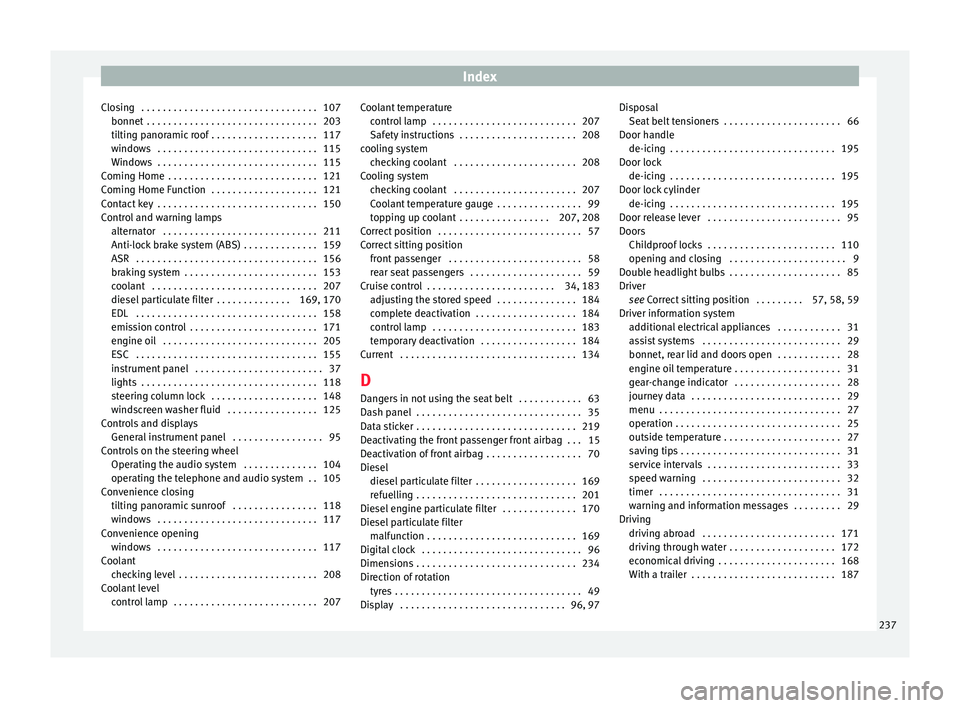
Index
Closing . . . . . . . . . . . . . . . . . . . . . . . . . . . . . . . . . 107 bonnet . . . . . . . . . . . . . . . . . . . . . . . . . . . . . . . .
203
ti ltin g p
anoramic roof . . . . . . . . . . . . . . . . . . . . 117
windows . . . . . . . . . . . . . . . . . . . . . . . . . . . . . . 115
Windows . . . . . . . . . . . . . . . . . . . . . . . . . . . . . . 115
Coming Home . . . . . . . . . . . . . . . . . . . . . . . . . . . . 121
Coming Home Function . . . . . . . . . . . . . . . . . . . . 121
Contact key . . . . . . . . . . . . . . . . . . . . . . . . . . . . . . 150
Control and warning lamps alternator . . . . . . . . . . . . . . . . . . . . . . . . . . . . . 211
Anti-lock brake system (ABS) . . . . . . . . . . . . . . 159
ASR . . . . . . . . . . . . . . . . . . . . . . . . . . . . . . . . . . 156
braking system . . . . . . . . . . . . . . . . . . . . . . . . . 153
coolant . . . . . . . . . . . . . . . . . . . . . . . . . . . . . . . 207
diesel particulate filter . . . . . . . . . . . . . . 169, 170
EDL . . . . . . . . . . . . . . . . . . . . . . . . . . . . . . . . . . 158
emission control . . . . . . . . . . . . . . . . . . . . . . . . 171
engine oil . . . . . . . . . . . . . . . . . . . . . . . . . . . . . 205
ESC . . . . . . . . . . . . . . . . . . . . . . . . . . . . . . . . . . 155
instrument panel . . . . . . . . . . . . . . . . . . . . . . . . 37
lights . . . . . . . . . . . . . . . . . . . . . . . . . . . . . . . . . 118
steering column lock . . . . . . . . . . . . . . . . . . . . 148
windscreen washer fluid . . . . . . . . . . . . . . . . . 125
Controls and displays General instrument panel . . . . . . . . . . . . . . . . . 95
Controls on the steering wheel Operating the audio system . . . . . . . . . . . . . . 104
operating the telephone and audio system . . 105
Convenience closing tilting panoramic sunroof . . . . . . . . . . . . . . . . 118
windows . . . . . . . . . . . . . . . . . . . . . . . . . . . . . . 117
Convenience opening windows . . . . . . . . . . . . . . . . . . . . . . . . . . . . . . 117
Coolant checking level . . . . . . . . . . . . . . . . . . . . . . . . . . 208
Coolant level control lamp . . . . . . . . . . . . . . . . . . . . . . . . . . . 207 Coolant temperature
control lamp . . . . . . . . . . . . . . . . . . . . . . . . . . . 207
Safety instructions . . . . . . . . . . . . . . . . . . . . . . 208
cooling system checking coolant . . . . . . . . . . . . . . . . . . . . . . . 208
Cooling system checking coolant . . . . . . . . . . . . . . . . . . . . . . . 207
Coolant temperature gauge . . . . . . . . . . . . . . . . 99
topping up coolant . . . . . . . . . . . . . . . . . 207, 208
Correct position . . . . . . . . . . . . . . . . . . . . . . . . . . . 57
Correct sitting position front passenger . . . . . . . . . . . . . . . . . . . . . . . . . 58
rear seat passengers . . . . . . . . . . . . . . . . . . . . . 59
Cruise control . . . . . . . . . . . . . . . . . . . . . . . . 34, 183 adjusting the stored speed . . . . . . . . . . . . . . . 184
complete deactivation . . . . . . . . . . . . . . . . . . . 184
control lamp . . . . . . . . . . . . . . . . . . . . . . . . . . . 183
temporary deactivation . . . . . . . . . . . . . . . . . . 184
Current . . . . . . . . . . . . . . . . . . . . . . . . . . . . . . . . . 134
D Dangers in not using the seat belt . . . . . . . . . . . . 63
Dash panel . . . . . . . . . . . . . . . . . . . . . . . . . . . . . . . 35
Data sticker . . . . . . . . . . . . . . . . . . . . . . . . . . . . . . 219
Deactivating the front passenger front airbag . . . 15
Deactivation of front airbag . . . . . . . . . . . . . . . . . . 70
Diesel diesel particulate filter . . . . . . . . . . . . . . . . . . . 169
refuelling . . . . . . . . . . . . . . . . . . . . . . . . . . . . . . 201
Diesel engine particulate filter . . . . . . . . . . . . . . 170
Diesel particulate filter malfunction . . . . . . . . . . . . . . . . . . . . . . . . . . . . 169
Digital clock . . . . . . . . . . . . . . . . . . . . . . . . . . . . . . 96
Dimensions . . . . . . . . . . . . . . . . . . . . . . . . . . . . . . 234
Direction of rotation tyres . . . . . . . . . . . . . . . . . . . . . . . . . . . . . . . . . . . 49
Display . . . . . . . . . . . . . . . . . . . . . . . . . . . . . . . 96, 97 Disposal
Seat belt t ensioners . . . . . . . . . . . . . . . . . . . . . . 66
Door handle de-icing . . . . . . . . . . . . . . . . . . . . . . . . . . . . . . . 195
Door lock de-icing . . . . . . . . . . . . . . . . . . . . . . . . . . . . . . . 195
Door lock cylinder de-icing . . . . . . . . . . . . . . . . . . . . . . . . . . . . . . . 195
Door release lever . . . . . . . . . . . . . . . . . . . . . . . . . 95
Doors Childproof locks . . . . . . . . . . . . . . . . . . . . . . . . 110
opening and closing . . . . . . . . . . . . . . . . . . . . . . 9
Double headlight bulbs . . . . . . . . . . . . . . . . . . . . . 85
Driver see Correct sitting position . . . . . . . . . 57, 58, 59
Driver information system additional electrical appliances . . . . . . . . . . . . 31
assist systems . . . . . . . . . . . . . . . . . . . . . . . . . . 29
bonnet, rear lid and doors open . . . . . . . . . . . . 28
engine oil temperature . . . . . . . . . . . . . . . . . . . . 31
gear-change indicator . . . . . . . . . . . . . . . . . . . . 28
journey data . . . . . . . . . . . . . . . . . . . . . . . . . . . . 29
menu . . . . . . . . . . . . . . . . . . . . . . . . . . . . . . . . . . 27
operation . . . . . . . . . . . . . . . . . . . . . . . . . . . . . . . 25
outside temperature . . . . . . . . . . . . . . . . . . . . . . 27
saving tips . . . . . . . . . . . . . . . . . . . . . . . . . . . . . . 31
service intervals . . . . . . . . . . . . . . . . . . . . . . . . . 33
speed warning . . . . . . . . . . . . . . . . . . . . . . . . . . 32
timer . . . . . . . . . . . . . . . . . . . . . . . . . . . . . . . . . . 31
warning and information messages . . . . . . . . . 29
Driving driving abroad . . . . . . . . . . . . . . . . . . . . . . . . . 171
driving through water . . . . . . . . . . . . . . . . . . . . 172
economical driving . . . . . . . . . . . . . . . . . . . . . . 168
With a trailer . . . . . . . . . . . . . . . . . . . . . . . . . . . 187
237
Page 240 of 252
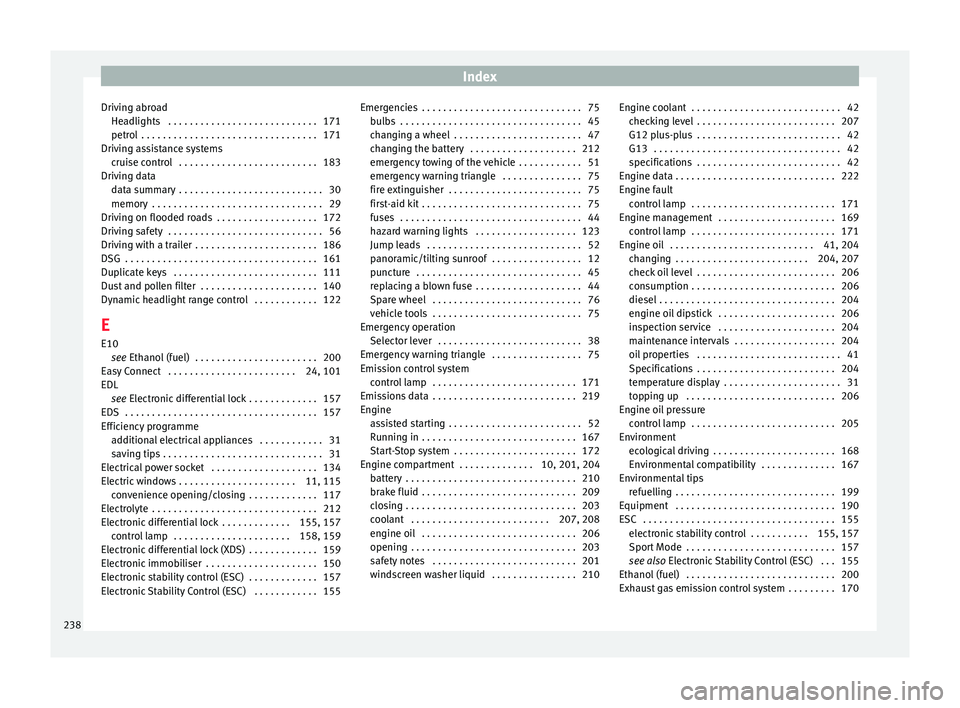
Index
Driving abroad He a
dlights . . . . . . . . . . . . . . . . . . . . . . . . . . . .
171
petrol . . . . . . . . . . . . . . . . . . . . . . . . . . . . . . . . . 171
Driving assistance systems cruise control . . . . . . . . . . . . . . . . . . . . . . . . . . 183
Driving data data summary . . . . . . . . . . . . . . . . . . . . . . . . . . . 30
memory . . . . . . . . . . . . . . . . . . . . . . . . . . . . . . . . 29
Driving on flooded roads . . . . . . . . . . . . . . . . . . . 172
Driving safety . . . . . . . . . . . . . . . . . . . . . . . . . . . . . 56
Driving with a trailer . . . . . . . . . . . . . . . . . . . . . . . 186
DSG . . . . . . . . . . . . . . . . . . . . . . . . . . . . . . . . . . . . 161
Duplicate keys . . . . . . . . . . . . . . . . . . . . . . . . . . . 111
Dust and pollen filter . . . . . . . . . . . . . . . . . . . . . . 140
Dynamic headlight range control . . . . . . . . . . . . 122
E E10 see Ethanol (fuel) . . . . . . . . . . . . . . . . . . . . . . . 200
Easy Connect . . . . . . . . . . . . . . . . . . . . . . . . 24, 101
EDL see Electronic differential lock . . . . . . . . . . . . . 157
EDS . . . . . . . . . . . . . . . . . . . . . . . . . . . . . . . . . . . . 157
Efficiency programme additional electrical appliances . . . . . . . . . . . . 31
saving tips . . . . . . . . . . . . . . . . . . . . . . . . . . . . . . 31
Electrical power socket . . . . . . . . . . . . . . . . . . . . 134
Electric windows . . . . . . . . . . . . . . . . . . . . . . 11, 115 convenience opening/closing . . . . . . . . . . . . . 117
Electrolyte . . . . . . . . . . . . . . . . . . . . . . . . . . . . . . . 212
Electronic differential lock . . . . . . . . . . . . . 155, 157 control lamp . . . . . . . . . . . . . . . . . . . . . . 158, 159
Electronic differential lock (XDS) . . . . . . . . . . . . . 159
Electronic immobiliser . . . . . . . . . . . . . . . . . . . . . 150
Electronic stability control (ESC) . . . . . . . . . . . . . 157
Electronic Stability Control (ESC) . . . . . . . . . . . . 155 Emergencies . . . . . . . . . . . . . . . . . . . . . . . . . . . . . . 75
bulb s . . . . . . . . . . . . . . . . . . . . . . . . . . . . . . . . . . 45
changing a wheel . . . . . . . . . . . . . . . . . . . . . . . . 47
changing the battery . . . . . . . . . . . . . . . . . . . . 212
emergency towing of the vehicle . . . . . . . . . . . . 51
emergency warning triangle . . . . . . . . . . . . . . . 75
fire extinguisher . . . . . . . . . . . . . . . . . . . . . . . . . 75
first-aid kit . . . . . . . . . . . . . . . . . . . . . . . . . . . . . . 75
fuses . . . . . . . . . . . . . . . . . . . . . . . . . . . . . . . . . . 44
hazard warning lights . . . . . . . . . . . . . . . . . . . 123
Jump leads . . . . . . . . . . . . . . . . . . . . . . . . . . . . . 52
panoramic/tilting sunroof . . . . . . . . . . . . . . . . . 12
puncture . . . . . . . . . . . . . . . . . . . . . . . . . . . . . . . 45
replacing a blown fuse . . . . . . . . . . . . . . . . . . . . 44
Spare wheel . . . . . . . . . . . . . . . . . . . . . . . . . . . . 76
vehicle tools . . . . . . . . . . . . . . . . . . . . . . . . . . . . 75
Emergency operation Selector lever . . . . . . . . . . . . . . . . . . . . . . . . . . . 38
Emergency warning triangle . . . . . . . . . . . . . . . . . 75
Emission control system control lamp . . . . . . . . . . . . . . . . . . . . . . . . . . . 171
Emissions data . . . . . . . . . . . . . . . . . . . . . . . . . . . 219
Engine assisted starting . . . . . . . . . . . . . . . . . . . . . . . . . 52
Running in . . . . . . . . . . . . . . . . . . . . . . . . . . . . . 167
Start-Stop system . . . . . . . . . . . . . . . . . . . . . . . 172
Engine compartment . . . . . . . . . . . . . . 10, 201, 204 battery . . . . . . . . . . . . . . . . . . . . . . . . . . . . . . . . 210
brake fluid . . . . . . . . . . . . . . . . . . . . . . . . . . . . . 209
closing . . . . . . . . . . . . . . . . . . . . . . . . . . . . . . . . 203
coolant . . . . . . . . . . . . . . . . . . . . . . . . . . 207, 208
engine oil . . . . . . . . . . . . . . . . . . . . . . . . . . . . . 206
opening . . . . . . . . . . . . . . . . . . . . . . . . . . . . . . . 203
safety notes . . . . . . . . . . . . . . . . . . . . . . . . . . . 201
windscreen washer liquid . . . . . . . . . . . . . . . . 210 Engine coolant . . . . . . . . . . . . . . . . . . . . . . . . . . . . 42
checkin g level . . . . . . . . . . . . . . . . . . . . . . . . . . 207
G12 plus-plus . . . . . . . . . . . . . . . . . . . . . . . . . . . 42
G13 . . . . . . . . . . . . . . . . . . . . . . . . . . . . . . . . . . . 42
specifications . . . . . . . . . . . . . . . . . . . . . . . . . . . 42
Engine data . . . . . . . . . . . . . . . . . . . . . . . . . . . . . . 222
Engine fault control lamp . . . . . . . . . . . . . . . . . . . . . . . . . . . 171
Engine management . . . . . . . . . . . . . . . . . . . . . . 169 control lamp . . . . . . . . . . . . . . . . . . . . . . . . . . . 171
Engine oil . . . . . . . . . . . . . . . . . . . . . . . . . . . 41, 204 changing . . . . . . . . . . . . . . . . . . . . . . . . . 204, 207
check oil level . . . . . . . . . . . . . . . . . . . . . . . . . . 206
consumption . . . . . . . . . . . . . . . . . . . . . . . . . . . 206
diesel . . . . . . . . . . . . . . . . . . . . . . . . . . . . . . . . . 204
engine oil dipstick . . . . . . . . . . . . . . . . . . . . . . 206
inspection service . . . . . . . . . . . . . . . . . . . . . . 204
maintenance intervals . . . . . . . . . . . . . . . . . . . 204
oil properties . . . . . . . . . . . . . . . . . . . . . . . . . . . 41
Specifications . . . . . . . . . . . . . . . . . . . . . . . . . . 204
temperature display . . . . . . . . . . . . . . . . . . . . . . 31
topping up . . . . . . . . . . . . . . . . . . . . . . . . . . . . 206
Engine oil pressure control lamp . . . . . . . . . . . . . . . . . . . . . . . . . . . 205
Environment ecological driving . . . . . . . . . . . . . . . . . . . . . . . 168
Environmental compatibility . . . . . . . . . . . . . . 167
Environmental tips refuelling . . . . . . . . . . . . . . . . . . . . . . . . . . . . . . 199
Equipment . . . . . . . . . . . . . . . . . . . . . . . . . . . . . . 190
ESC . . . . . . . . . . . . . . . . . . . . . . . . . . . . . . . . . . . . 155 electronic stability control . . . . . . . . . . . 155, 157
Sport Mode . . . . . . . . . . . . . . . . . . . . . . . . . . . . 157
see also Electronic Stability Control (ESC) . . . 155
Ethanol (fuel) . . . . . . . . . . . . . . . . . . . . . . . . . . . . 200
Exhaust gas emission control system . . . . . . . . . 170
238